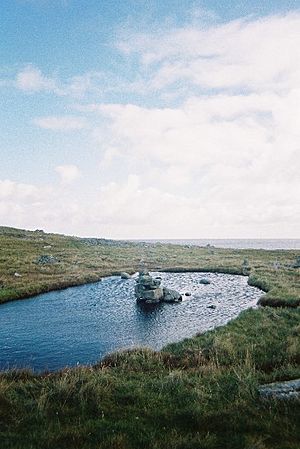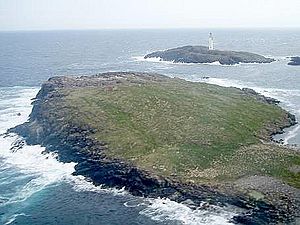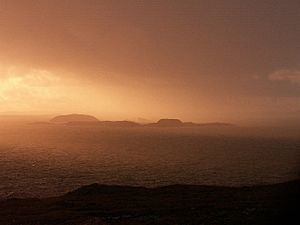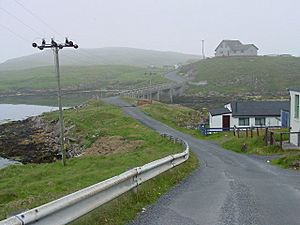Out Skerries facts for kids
| OS grid reference | HU681718 |
|---|---|
| Coordinates | 60°25′N 0°46′W / 60.417°N 0.767°W |
| Physical geography | |
| Island group | Shetland |
| Area | 400 hectares (990 acres) |
| Highest elevation | Bruray Wart 53 metres (174 ft) |
| Administration | |
| Sovereign state | United Kingdom |
| Country | Scotland |
| Council area | Shetland Islands Council |
| Demographics | |
| Population | 30 |
The Out Skerries are a group of small islands, some with people living on them, located in Shetland, Scotland. They are the most eastern part of Shetland. Locals often call them Da Skerries or simply Skerries.
Contents
Exploring the Geography of Out Skerries
The Out Skerries are about 6 kilometres (4 mi) northeast of Whalsay. Bound Skerry, one of the islands, is the most eastern point of Shetland. It's only about 300 km (around 190 miles) west from Tjeldstø in Norway. The main islands where people live are Housay, Bruray, and Grunay.

Many smaller rocky islands, called skerries, islets, and stacks, surround the main group. These include the Hevda Skerries and Wether Holm to the north. To the south, you'll find the Holm. Lamba Stack and Flat Lamba Stack are to the east. Stoura Stack and the Hogg are south of Grunay. Bound Skerry, which has a lighthouse, is next to Little Bound Skerry and Horn Skerry.
Beyond Mio Ness, at the southwest tip of Housay, are North and South Benelip and the Easter Skerries. You can also find Filla, Short and Long Guen (known as the Guens), Bilia Skerry, and Swaba Stack. There's also an isolated group of islands between the Out Skerries and the Shetland Mainland. These include Little Skerry and the Vongs. Muckle Skerry is another island located further north.
Understanding the Names of the Skerries
Most of the names in the Skerries come from Old Norse, the language of the Vikings. The word "Out" in Out Skerries comes from two Old Norse words. Austr means "east," which might have helped tell them apart from the Ve Skerries (or "west skerries"). Also, utsker means "outer," referring to their location. The word "Skerry" itself comes from the Old Norse sker, meaning a small rocky island or reef.
Housay comes from the Old Norse Húsey, which means "house island." However, locals today often call it "West Isle." Bruray might come from the Norse word brú, meaning "bridge island." This name could be because it sits between West Isle (Housay) and Grunay. Grunay simply means "green island." The name Bound Skerry is a bit harder to figure out. It might come from bønn, meaning "forerunner," because it was often the first land ships saw when sailing to Shetland from Bergen, Norway.
A Look at the History of Out Skerries
The Out Skerries have a long and interesting past.
Ancient Times: Prehistory on the Islands
People lived on the Out Skerries even in ancient times. There's proof of people living here during the Neolithic period (New Stone Age), including two old house sites at Queyness. The Battle Pund is a rectangle about 13 metres (43 ft) across, marked by large rocks. It dates back to the Bronze Age. Its purpose is still a mystery.
On the north shore of Grunay, there's a large ruined structure locally called "the broch." We don't know for sure if it's from the Iron Age, when similar tower-like structures were built across northern Scotland. The name "Benelips" might come from the Old Norse word bon, meaning "to pray." This hints that early Christian hermits might have lived on these remote islets.
Some stories suggest that the folklore of troll-like creatures called trows and perhaps selkies (seal-people) might have come from the arrival of the Norse settlers. It's thought that when the Vikings arrived, the native, dark-haired Picts went into hiding. Many stories in Shetland tell of these "strange people," who were smaller and darker than the tall, blond Vikings. These stories say they were driven into sea caves and would come out at night to take things from the new landowners. The skerry called Trollsholm and its rocky crack, Trolli Geo, show that this folklore is part of the Out Skerries' history.
Later History: From Norse Settlers to Shipwrecks
People have lived on the Out Skerries continuously since the Norse period.
Many ships have been wrecked around the islands. These include the Dutch ships Kennemerland (in 1664) and De Liefde (in 1711). Another ship, the North Wind (in 1906), was carrying wood. The islanders salvaged this wood and used it to build their houses. Some gold from these wrecks was even found in 1960. The wrecks of the Kennemerland and the Danish warship Wrangles Palais (in 1687) are now protected as Historic Marine Protected Areas.
Because the islands are so remote and rugged, islanders were sometimes accused of smuggling goods and taking things from shipwrecks. There's a place called Tammy Tyrie's Hidey Hol, which islanders used to hide from "press gangs" – groups who would force men to join the navy.
Until the early 1900s, a lot of deep-sea fishing (called haaf fishing) was done from traditional fishing boats known as sixareens.

World War II and the Islands
Being so close to Norway, the islands were very important during World War II. They were a common landing spot for Norwegian boats carrying people escaping from the Nazi occupation. The local coastguard was in charge of helping these refugees. At one point, they were even given a machine gun, though no one knew how to use it at first! German planes often flew low over the islands. In 1941, they shot at the Grunay lighthouse station, and in 1942, they dropped a bomb. This attack sadly killed Mary Anderson, who was the only local person to die in the war. Grunay was then emptied of its residents shortly after. A month later, a Canadian bomber plane crashed on Grunay. In 1990, a special plaque was put up to remember this event. The bomber was a British Blenheim bomber with a crew of two Canadians and one Englishman. The family of Flight Sergeant Jay Oliver, one of the Canadian crew members, attended the plaque ceremony. Peter Johnson, a local man who saw the crash when he was eight years old, was also there. During the war, a secret letter was sent to the local postmistress with instructions to open it only if Germany invaded. After the war, it was returned, still unopened.
Life on the Out Skerries Today
Around 35 people live on the two main islands, Housay and Bruray. A third island, Grunay, is currently empty. The two main islands are connected by a bridge. The islands have two shops, a small airport runway, a church on Housay, a police station, a fish processing factory, and a community hall. Dances are often held at the community hall, especially for the yearly Lerwick to Skerries Yacht Race in August. The islands are also known for their amazing wildlife, and rare birds are often seen there.
There isn't much peat (a type of fuel from decayed plants) on the Out Skerries. So, the people living there are allowed to cut peat on Whalsay. The soil on the islands is thin and not very fertile. However, islanders pile it up into long mounds called riggs to grow vegetables like potatoes, carrots, and swedes better. The main job on the islands is fishing. There's still some sheep farming, but it's not as important as it used to be. Tourism, on the other hand, has grown.
The islands used to have a primary school, but it's now closed. In 2015, the primary school had only one student. The secondary school, which was once the smallest in the UK, had only three students in 2010. This secondary school was closed in 2014 by the Scottish government. In 2016, the school had just one student. His story became very popular, and he received 10,000 Christmas cards that year from all over the world!
The old schoolhouse has found a new purpose. It's now the second-smallest cinema in the UK (and the smallest in Scotland), called Schoolhouse Cinema. It opened in 2017 and offers free entry and free snacks.
Getting Around the Out Skerries
- The Skerries Bridge connects Bruray to Housay. It was built in 1957, replacing an older bridge from 1899.
- There's about a mile of road on the islands, where most of the people live.
- You can take a ferry to the islands from Vidlin and Lerwick.
- There's also a small airport runway on Bruray.
See also
 In Spanish: Skerries Exteriores para niños
In Spanish: Skerries Exteriores para niños





